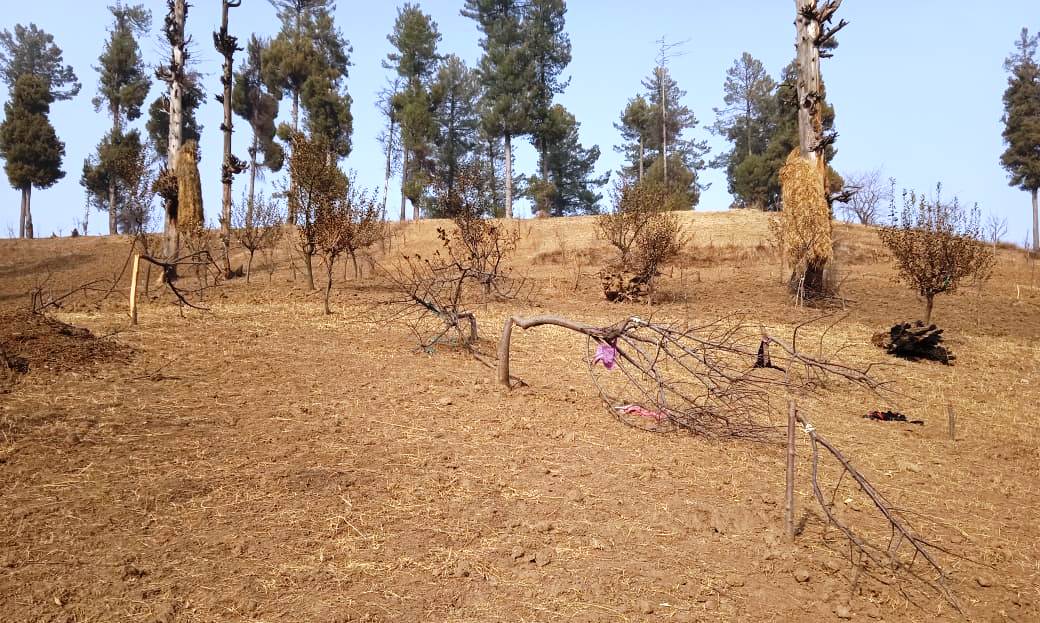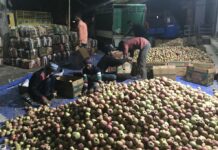The Forest Department issued notices to all the ‘encroachers’ everywhere. But a patch on Budgam-Pulwama border was the only place across Jammu and Kashmir where orchard axing took place. With the mass felling, Umar Mukhtar reports the residents have lost hope of a possible dignified future

On November 28, Farooq Ahmad, 42, a resident of Sekloo hamlet of Pulwama trekked down a kilometre to the nearby Sonbanjar village to cast his vote. It was the first phase of the district development council (DDC) elections. Till now, Farooq had never voted.
Unlike past elections, Ahmad cast his vote in the hope to secure the possession of the land that he and his family has been cultivating for decades. A month ago, he and some other people were served the eviction notices by the forest department. They were asked to vacate the land within a week.
Ahmad, a labourer by profession lives in a single-story modest cracked house on a slope. He has worked hard on his orchard over the past many years hoping that once the orchards bear fruit, it would change their lives.
A week after the notices were served, forest officials cut the whole orchard of Ahmad spread over an area of 30 marlas of land. Ahmad had planted more than 100 trees. Some of the trees had borne fruits this year for the first time.
“It takes almost a decade of hard work and care to set up an orchard that bears fruits,” Ahmad said. “My ancestors used to cultivate maize and vegetables on these lands but I felt horticulture can at least make our lives easy. I had planted apple trees and had invested all my savings and time in it.”
Interestingly this development of serving notices and cutting of trees was initiated days ahead of the first phase of the DDC elections. According to Ahmad, the DDC candidates in these areas have asked people to vote in order to save the lands that these people were cultivating for ages.
“I voted for the first time in the hope to not lose my lands else there will be nothing left with me,” Ahmad said.
Ahmad has six family members to feed.
The Village
Sekloo (or Sekul meaning sandy) village is set on the slopes of picturesque hillocks surrounded by the forests on the way to the famous tourist destination of Yousmarg. Below the hillocks flows Romshi Nalla. The village of around 40 households has very little land for cultivation. It mostly relies on the nearby forest lands where they cultivate maize and apples. People have very less or almost no private lands. The topography of the village hardly provides a space to construct a dwelling.
At the same time, the cultivation of land is the only source of income for the villagers. Earlier the villagers practised the profession of hair-cutting but over the years as the profession was taken over by the outsiders, they have now taken to performing menial labour work in the nearby villages besides cultivating the sparse land in the area.
“We survive on this land,” said Ghulam Qadir, village’s senior resident.
Prior to 2002, all the villagers used to live in the hutments. Under a government scheme, they were provided with the two-room single-story concrete house. As the small 2-room homes sprung up over the slopes, it gave the village a picturesque setting. It looked like a set for a film.
In practical terms, it ended up like a temporary film set. As the village has a downhill topography, after some years, the concrete structures developed cracks.
“It is all because of the land-sliding. Basically, a stream runs on the upper side of the village that has leaks on various points, that seepage causes the land sliding,” said Qadir.
Owing to all these reasons, the residents of this village have not found time to go to school. Some who did eventually dropped out of school soon. That is perhaps why the village has only one government employee who works at a nearby public health works department. He later donated land for the construction of the tube well.
The village continues to be impoverished. There is no electricity transformer in the village. The village receives power supply from Sonbanjar. Frustrated and hopeless from all sides, the residents had finally worked hard on cultivating apple orchards. They were hopeful of the positive transformation of their lives in the near future as the trees started bearing fruit. No longer. “Around 15000 trees were cut in our belt and in the nearby areas,” said Qadir.
From the same village, the orchard of the Abdul Hameed Hajam was cut down by the forest department. He had planted 80 apple trees a decade ago. “I have lost everything now,” he said.
Hameed added that by virtue of living near the forest he like other villagers was entitled to land. “We have not usurped the lands; we know each and every aspect of social forestry. We are living here since ages in a symbiotic relationship with nature,” he said. “If not these lands wherefrom shall we get the lands parachuted here. We were born here and it is not our fault”.
The apple trees of Ghulam Nabi Hajam, Ghulam Ahmad Hajam, and Shakeel Ahmad Hajaam were also cut. The others too have received the eviction notices but the axe is yet to reach their trees.
The villagers said that they are the forest dwellers but did not have an iota of the idea about the forest rights or forest rights act (FRA).
The estimated forest area in Jammu and Kashmir is 20,230 square kilometres which constitute 19.95 per cent of the total geographical area of the union territory.
Not far away from the Sekloo, is Kandajan, a village of 400 households where Showkat Ahmad Wagay’s orchard was also cut. It was his only source of income. Wagay said his family have been cultivating the land for the past 100 years.
Wagay said that the forest department had cut his 300 apple trees. In the same village, the forest department axed 150 apple trees of Abdul Razaq Wagay, who has been cultivating five kanals of forest land for the last many decades. Wagay said the families of Kanidajen had been cultivating the land for about 150 years. He said that these lands were allotted to them in the 1950s under the Grow More Food programme by Sheikh Mohammad Abdullah, the then Prime Minister of Jammu and Kashmir.
In this village, almost 10 families claimed that their apple trees were cut by the officials.
The forest department on its official website has issued the list of alleged forestland encroachers in 32 forest divisions — 12 falling in Kashmir and 20 in Jammu region. As per officials, an estimated 2.96 lakh kanals of forestland stands encroached upon across Jammu and Kashmir.
The highest area of forestland encroached upon is in Jammu region’s Ramban forest division (2,106 hectares), followed by Rajouri division (1,973.9 hectares), Poonch (1,472 hectares) and Shopian (1,026.77 hectares), which is in Kashmir division. Further, in Anantnag forest division, 6,583 encroachment cases involving 1,496 hectares of land have been reported.
The eviction notices were served at many other places also but apple trees were cut here only.















